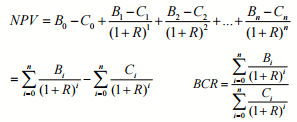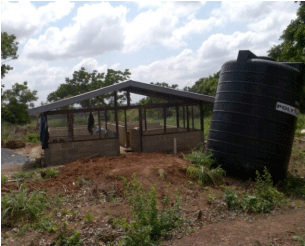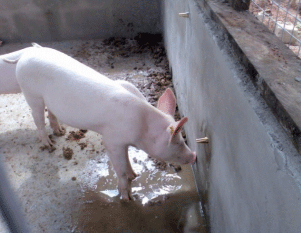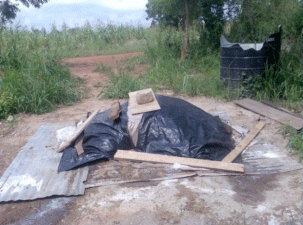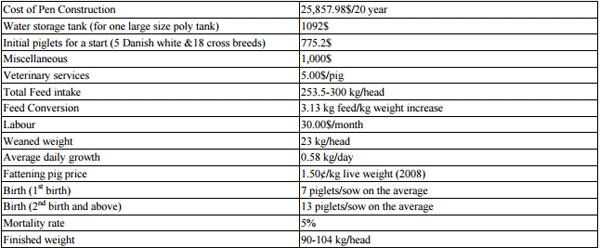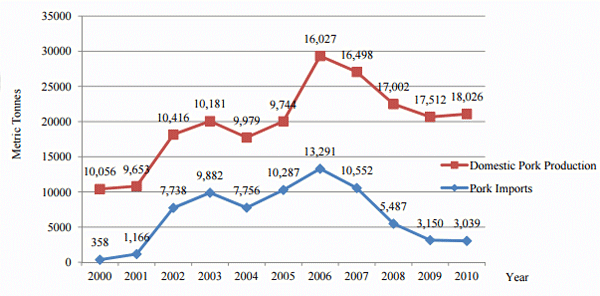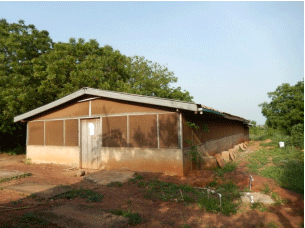1. Introduction
Livestock represent a form of cash security of the livelihood strategies of many poor and disadvantaged rural and peri-urban communities in Ghana [1-3]. For farmers, livestock play a central role in their socio-economic and cultural identity and are a source of food, employment, food security and also assets for store or trade [4, 5]. Table 1 shows the current shortfalls, demand and production levels of livestock production in Ghana. The level of demand is far more than current domestic production [6]. The growth of Ghana’s domestic livestock industry has been impeded by several constraints such as lack of improved breeding stock and production information leading to importation to subsidise meat consumption (Table 1). This crisis and change have created new needs and the fulfillment of these needs is a business opportunity with the potential to provide employment and sustainable income generation. Recent developments show that the country has the potential to increase the off-take of livestock and produce good quality meat to satisfy a greater part of the nation’s animal protein requirements.
Pork is the most widely consumed meat in the world [7, 8]. People eat many different pork products, such as bacon, sausage, pork chops and ham. Several valuable products or by-products, in addition to meat, come from swine.
Table 1 Livestock production status in Ghana [9].
These include insulin for the regulation of diabetes; valves for human heart surgery; suede for shoes and clothing; and gelatin for many food and non-food uses. Swine by-products are also important parts of such products as water filters, insulation, rubber, antifreeze, certain plastics, floor waxes, crayons, chalk, adhesives and fertilizer [10]. However, inflating costs for swine feed and swine production have increased (worsened the plight of pig farmers and result to rising)pork price and contributed to the world shortage of pork products [11].
Since 2008 to 2013, pork prices in Ghana rose rapidly between 115-120 percent i.e., the price of a kilogram of pork ranged between 2.1$ to 4.53$ depending on maintenance. Rising meat and food prices in Ghana are part of a bigger trend of increasing fuel costs.
In the last ten years, Ghana’s market for pork has been rising at an impressive rate which is well above that of other livestock products. This pattern in various regions of Ghana has been shaped by several factors such as demographic growth, economic, scientific and technological progress as well as policies aimed at increasing production [12]. Other factors contributing to the increasing widespread consumer acceptance with respect to pork and pork products include dietary concerns which favour substitution of red meat with white meat and industry effort in creating added values to respond to consumer demand for innovative and high quality products [13]. Swine rearing and pork production has also recently attracted the growing interest of Ghanaian farmers who seek diversification of enterprises following a period of low profitability.
Swine rearing is highly prolific and can be used to increase meat production in a very short time. Growth rate is high (90-100 kg in 6-7 month) and pork meat is lean and accounts for 70%/100 kg pig carcass which is higher than other meat-producing animals. Furthermore, the Rate of Returns is relatively higher for pig production. These have led markedly to the change in the economics of pig production in recent years. Feed, as a percentage of total costs, has increased as well as the costs of weaner production. Swine production in Ghana occurs in many varied types of systems or facilities. These range from a pasture facility where pigs have little or no shelter and can move throughout a field, to one where pigs are totally confined. Swine need housing to keep them warm during cold temperatures and to shelter them from excessive heat [14]. Pigs are sensitive to heat and could die from heat stress [15]. When housed indoors, temperature conditions must be well regulated. Controlled temperature conditions can help maximize pig productivity. Cooling mechanisms for pigs can be in the form of drip water system or a wallow (for a hog pen) [16]. Pigs can be housed indoors in individual stalls, pens (in groups or batch) or in barns. Even if the pigs are raised outdoors they would need a shelter during cold and hot weathers. The housing should have a space for feeding and bedding. Management, facility and equipment needs, labour and ration needs vary between systems. The confined, also referred to as the intensive system is the most appropriate system for the elite Danish Large White breed because of their susceptibility and vulnerability to new housing and feeding requirements [17].
For example in Ghana, warm environmental conditions do not usually result in death losses, but they can cause reduced growth performance in growing-finishing pigs and decreased reproduction in the breeding herd [16]. In the sow, temperatures higher than 27 °C (80 °F) will delay or prevent the occurrence of estrus, reduce conception rate, and increase early embryonic death [16]. Therefore, for anyone seeking to establish a new pig production enterprise, information on market options, production systems and business benchmarks is essential. Therefore the Biotechnology and Nuclear Agricultural Research Institute Piggery Project hereafter referred to as the BNARI Piggery Project was established to combine the science and technology to carry out research and development activities on safe biotechnologies and nuclear techniques on swine production. Research outputs are transferred to end users in order to enhance swine productivity, industrialization, commercialisation and good resource management practices to improve livelihood [18].
This research outlines the key findings obtained from the BNARI Piggery Project established by the Biotechnology and Nuclear Agricultural Research Institute (BNARI) under the Ghana Atomic Energy Commission. Additional information was obtained from El-Capitano Farm Ltd at Agona, Duakwa, Nungua Farms (Livestock Unit of the Ministry of Food and Agriculture, MOFA), University of Ghana Farms, Abundant Grace farm at Dodowa, as well as personal interactions with experts on production, marketing and information on the cost/benefit analysis on swine production.
2. Materials and Methods
The financial analysis was done with data from the BNARI Piggery Project and other pig farmers. Investment appraisal, a simple form of benefit-cost analysis, Net Present Value (NPV), Internal Rate of Returns (IRR), and Pay Back Periods are used to analyze the financial efficiency. Additional costs due to the health (vaccinations) and parasitic control measures are also taken into consideration. The costs of constructing pig pens and rearing pigs indoors, additional feed and labour are included. Although the transmission of porcine cysticercosis in the area is unlikely depending on the method of rearing and feeding, it is hypothesized that the environment is already contaminated with Taeniasolium eggs, thus, susceptible pigs introduced to the area must be protected from infection even though they are reared indoors.
The net benefit of each particular option was calculated using the formula:
Net benefit = Total revenue−Total cost……………………….1
The NPV, BCR and IRR due to the future cash flows that this investment would generate were calculated from the following formula:
Where
Bi = Benefits of period i
Ci = Costs of period i
n = number of periods
R = interest rate
IRR = the interest rate ‘R’, where NPV = 0
The first phase of piggery pen construction consisting of eight chambers/cubicles (each chamber is 10 ft by 10 ft) was successfully completed early September 2008 as shown in Fig. 1. Two batches of pigs were procured for the purpose of breeding and fattening under the BNARI Piggery Project. Five pureDanish large white pigs (Fig. 2) were obtained from the Ministry of Food and Agriculture (MOFA) pig breeding station at Nungua on the 15th of September 2008. This batch consists of one young boar (30 kg) and four guilts of average weight (25 kg).
Fig. 1 First phase of pig pen.
Fig. 2 Danish Large White.
Eighteen exotic cross breeds of Danish large white and Dutch Hampshire were also purchased from Krieg Farms at Doryumu for fattening purposes and economy of scale. All pigs were weaners and their average weight at purchase was 28 kg. The initial cost in 2008 including land (2,521$), constructing 8 cubicle pig pens (4,250.5$), poly-tank (1,008$) to store water, cost of 5 Danish large white breeder pigs (4 sows and 1 boar) and 18 fattening pigs (731.1$ at 1.26$/kg live weight) and consultancy (840$) all amounted to 9, 350.6$. The cost of formulating one metric tonne of pig feed was also 378.2$ for rearing pigs indoors. The costs included additional feed, labour, veterinary services and contingency expenses (Table 2). This data was collected in March 2008 from management records of the BNARI Piggery Project.
Pig feeding was supplemented with brewer spent malt, treated with farm produced lactobacillus/probiotics to aid in digestion and nutrition. The lactobacillus preparation was obtained by washing one kilogram of rice in a half gallon (2.25 L) of non-chlorinated water. This washed water was placed in a bucket half way to the lid to allow for 5-7 days spontaneous fermentation in a cool environment not exceeding 28 °C. The liquid was strained and 5 gal (22.5 L) of fresh milk was added to eliminate undesirable microbes and enhance the proliferation of lactobacillus spp. The liquid mixture was fermented again in the same cold environment not exceeding 28 °C for 10 days to obtain a yellow liquid containing lactobacillus spp. The brewer spent malt treated with the lactobacillus was prepared the day before incorporating it in the formulated diet to feed the pigs. The lactobacillus preparation was diluted at 0.1 L per gal and sprayed on the brewer spent malt 24 hour before using it to supplement the formulated pig diet. Fig. 3 shows brewer spent malt sprayed with the lactobacillus preparation and covered with plastic mulch and Fig. 4 demonstrates spent malt being dried. Pig manure was converted to cash by introducing black soldier flies to break them down odourless at BNARI premises. The larvae of the black soldier flies fed on the pig manure and the larvae were harvested and fed to back yard fishes in tanks. The sediment after harvesting the larvae was used as organic manure for vegetable cultivation. Fig. 4A is an experimental “larvaeculture” with black soldier larvae and pig manure in liquid manure experimentation. The black soldier fly as shown in Fig. 4B lays eggs which before they metamorphosed into the parent insect, hatch into larvae and feed on the pig manure as shown in Fig. 4C.
The cost of rearing pigs indoors is calculated as the sum of the cost of maintenances and feeding the pig to market weight using various feed combinations.
Fig. 3 Sprayed brewer spent malt with lactobacillus.
Fig. 4 Drying brewer spent malt.
2.1 Assumptions
Based on findings, it was estimated that a good pigpen constructed will last for at least 20 years before it would be replaced. The time horizon of 20 years is therefore used in the financial analysis of the intervention. In addition, the following assumptions are made:
- The pigs are kept as fattening and not as breeders. This is an option preferred by most smallholder pig farmers in Ghana.
- Each pig consumes the same weight of feed per day.
- A pig is replaced immediately after the previous one has been sold.
- Vaccinations and parasite control are administered once a year.
- Constant prices are used. For planning purposes, prices in the planning year were applied for all twenty years and real discount rates (discount rates that are free from the effect of inflation) were used in order to make the benefits and costs comparable in terms of the time dimension.
- Breeders will be changed after every 4 years.
- The study also assumed that pigs will be kept indoors with recommended practices. Hence, an “intention-to-treat” approach is used.
- A capital cost of the project (that is, opportunity costs of other feed supplements and veterinary services) is taken into account. The cost of constructing pigpens is expressed as an initial lump-sum, which will occur at the end of Year zero of the BNARI Piggery Project.
The financial analysis was done using an Excel spreadsheet model. In calculating the costs and benefits according to information obtained from pig farmers and expects, the respective sequences of events were taken into account. For example, total revenue from pigs is calculated using the following formula:
Total revenue = Revenue from healthy pigs
3. Results and Discussions
3.1 Financial Analysis
Smallholder pig farmers reported that it would cost on average about 17$ to feed a penned pig to slaughter weight with various combinations of leftover food from restaurants but only about 5.2$ for a free-range/tethered pig. Similarly, farmers reported that the average cost of labour charged to care for a penned pig per month is 9.5$ but only about 4.3$ for a free-range/tethered pig.
On the other hand, large scale pig expert farmers reported that the cost of balanced feed meal per pig may range from 40$ to 110$ from birth to finished weight depending on the content and purpose for which the pig is to serve. They also emphasized skilled labour as the most important factor to consider in pig rearing especially being able to detect when animal is on heat for timely mating.
Fig.5 Black soldier fly permaculture system with pig waste.
Table 2 Parameter values used in the models: Technical performances and Prices, 2008.
The above costs were considered regardless of whether the farmer did the work herself/himself or employed someone else. A labourer was employed internally to see to day to day cleaning and feeding of the BNARI Piggery. The labourer was given 30$ per month as motivation and for extra work at weekends in addition to his salary (150$). According to Maslow Theory, as long as one is motivated to satisfy some needs growth and self-actualization occur and impact positively on productivity [19].
3.2 Analysis of Financial Efficiency
The project had a startup costs, operational costs, and incoming cash flows over twenty years. The project immediate (t = 0) cash outflow was of 25,857.98$. All cash flows are after-tax, and there are no cash flows expected after year 20. The basic analysis used a real annual interest rate of 10.51% offered by the Bank of Ghana in 2008 as the opportunity cost of the investment. The present values (PVs) were calculated for each year.
Benefit Cost Ratio451228/237629 = 1.899
NPV = 144,875$
The benefit cost ratio of the project has been computed based on the total cost and benefit of the project. BCR of 1.899 indicates that the project is economically viable.
Payback period = 1.80 y ≈ 22 months after project take off
With this project, the Benefits that will be accrued over the period of 20 years are positive value; meaning the project is in the status of discounted cash inflow in the time of 20 years. The BNARI project was worth investment.
The internal rate of return (IRR) was computed in the spreadsheet to reflect a discount rate that would make an NPV equal to zero.
To find the internal rate of return, the values of the rate (r), which satisfies the following equation was analyzed: IRR = r (IRR = 43.62%)
The IRR indicate efficiency of the investment, as opposed to net present value (NPV), which indicates value or magnitude. The IRR is the annualized effective compounded return rate which can be earned on the invested capital, i.e., the yield on the investment. Since the IRR is greater than the rate of returns that could be earn by alternative investment (investing in other projects, buying bonds, even putting the money in a bank account), it is a better investment proposition. Also lending the IRR is far better than the lending rate of 25%.
Sensitivity Analysis:
A sensitivity analysis was performed for the BNARI Piggery Project using the Bank of Ghana interest rates (10.51%), increase death rate (7%) and decreased birth rates (e.g., 3 times in two years instead of twice in a year). The analytical model is run taking all these factors into consideration to see whether changes in these values would affect the financial efficiency of the project.
Investment appraisal to adjust for risk
BCR = 313086/171600 = 1.825
NPV = 89,630¢
IRR = 33.23%
Payback period = 31 months
Results of the sensitivity analysis of the project under decrease rate of birth, and annual interest rates that the farmer would have to pay if he/she decided to borrow money from the bank in order to invest in the pig business indicated that the project would remain financially efficient regardless of the plausible changes in decreased birth rate, pig prices, bank interest rates and incidence rate of 7% mortality. However, the incremental NPV would be about two times higher if the institute Biotechnology and Nuclear Agriculture Research Institute (BNARI) grows its own crops to supplement pig feeding to reduce the cost of feed in addition to supplementing feeding with brewer spent malt.
3.3 Feeding
For the piggery industry, feed accounts for around 70% of production costs. The feed costs have reportedly increased by more than 226.6% since 2008-2013 and the current drought situation is set to worsen it. However the demand for piggery products is increasing, with rising prices.
All the pigs responded very well to feeding. Breeder pig consumed 1 kg per day of compounded breeder feed and 0.5 kg of brewer’s spent malt supplement. The fattening stock was fed on compounded ration for growers and brewers spent malt supplementation. Quantity of feed per pig/day was 1 kg of compounded feed and 0.5 kg of brewers spent malt supplement. Pigs responded very well to feeding with an average weekly weight gain of 3.65 kg per pigs over 30 kg and between 1-2.50 kg for pigs less than 30 kg. The cost of formulated pig feed (maize, wheat bran, fish meal, oyster shells, soybean meal, premix and anti-mould) increased from 275$ to 898$ per metric tonne within the period 2008 to 2013. However with feed supplement from brewer spent malt, feed cost as a percentage of production cost was reduced to 55. Quarterly sales of live and carcass weight increased slightly as the heavier pigs grew marginally faster. It was also noted that increasing live weight from 70 to 100 kg reduced production cost by 5% giving savings 0.50$ for every 4 kg increases.
3.4 Marketing
Pork is the most consumed meat in Ghana irrespective of rising prices. Pork marketing popularly known as “pork-show” is usually offered for sale in the form of primal cuts, generally consisting of the butt, picnic, belly, loin, offal, the head and legs on a piece of table outdoor closer to the owner’s farm. Ghana’s pork production and demand exhibits distinct continuous phenomenon which influences pork availability. Since domestic production cannot keep up with the demand for pork, Ghana imports processed pork to meet domestic demand as shown in Fig. 5. Although production systems vary across regions, farrowing and growth rates are still influenced by the quality of breed, feed and production systems which results in profit variability. In order to meet the demand of domestic pork consumption, Ghana government through the Ministry of Food and Agriculture imports improved pig breeds worldwide for breeding and distribution to local farmers. Domestic commercial production of pigs has grown significantly over the past decade, many as a result of increasing domestic meat production and consumption (Fig. 5).
Fig. 5 Pork imports into Ghana: 2000-2010 in metric tonnes (Source MOFA).
Fig. 6 Expanded piggery pen.
Fig. 7 Crossed breeds (Danish large + black Hampshire).
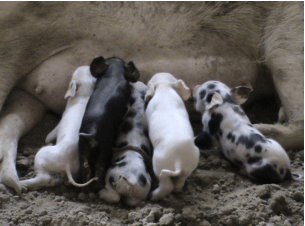
Marketing and demand has provided the opportunity for a value-added pork product such as sausages, bacons, ham, and pork chops, etc. The swine production system adopted by this project is dynamic and undergoing continuous evaluation of production technology and adjustments. These technologies impact pork productions as well as revenues. For example: cost advantages were obtained as a result of expanding the scale of operation due to economy of scale which resulted in higher profits. Economies of scale refers to the decreased per unit cost of inputs as the quantity of pigs increases. More clearly, the initial investment of capital is diffused (spread) over an increasing number of units of pigs, and therefore, the marginal cost of producing a pig is less than the average total cost per unit. As a result, the BNARI Piggery pen was expanded from 8 chambers to 20 (Fig. 6). In addition cross breeding was encouraged to increase pig’s adaptation to Ghana’s climates condition as shown in Fig. 7.
3.5 Pig Solid Waste Management
Pig manure especially from commercial production is noxious and offensive creating a pungent smell. BNARI approached a Ghanaian entrepreneur, Mr. K. A. Anno of K. A. Anno Engineering who has successfully used black soldier flies to decompose domestic waste to assist BNARI to manage the waste generated at the BNARI Piggery. BNARI’s entomologists are still conducting research to optimise the condition for the efficient operation of a biological waste management system (BWMS) for pig waste to reduce odour while generating compost with the shortest possible time. The BWMS would use the black soldier fly larvae to feed on the piggery waste to produce mature larvae and organic manure. The larvae would be harvested to feed fish aquaculture and the manure for vegetable production.
4. Conclusions
The piggery project was highly successful and invested capital was recouped within two years of project take-off. Collaboration with other farms and organisations and experts, have generated innovations in the area of improving feed cost and animal nutrition, waste management practices, and breeding. These innovations have been shared with both small and large-holder livestock farmers. In all aspect of the farm management, results achieved so far especially with pork carcass quality and profit margins are encouraging which have led to the expansion of the piggery. Large sample sizes or numbers are also needed for meaningful research work to establish significant conclusions. Expansion will result in more meaningful research work while benefiting from economy of scale. As the slogan goes, tomorrow’s challenges as opportunity for growth can be seen. The piggery is now self-sustained and still in operation at the Biotechnology and Nuclear Agricultural Research Institute of the Ghana Atomic Energy Commission.
Acknowledgments
The corresponding author would like to take this opportunity to express very sincere thanks and appreciation to BNARI for providing funds to make this project possible. I would also like to thank all pig Farmers who contributed with their involvement. In the latter category I am particularly grateful to Mohammed Yaro, Ebenezer Kondo, Francis andoh, and Aminu for their assistance, and my family especially my wife Irene Baaba Banson, and children Anastasia, Christina, Nana Baah, and Kojo Atta Banson for their love and support.
References
[1] Satterthwaite, D., and Tacoli, C. 2002. “Seeking an Understanding of Poverty that Recognizes Rural-urban Differences and Rural–urban Linkages.” In Urban Livelihoods: A people-Centred Approach to Reducing Poverty, edited by Lloyd-Jones, T., and Rakodi, C. United State: Earthscan.
[2] Maxwell, D., et al. 2000 Urban Livelihoods and Food and Nutrition Security in Greater Accra, Ghana. Washington, D. C.: International Food Policy Research Institute.
[3] Banson, K. E. 2014. Impact and Evaluation of Innovations on Marketing of Fresh Produce. Saarbrücken, Germany: LAP LAMBERT Academic Publishing OmniScriptum GmbH & Co. KG.
[4] Whitehead, A. 2002. “Tracking Livelihood Change: Theoretical, Methodological and Empirical Perspectives from North-east Ghana.” Journal of Southern African Studies 28 (3): 575-598.
[5] Gandini, G. C., and Villa, E. 2003. “Analysis of the Cultural Value of Local Livestock Breeds: A Methodology.” Journal of Animal Breeding and Genetics 120 (1): 1-11.
[6] De Leeuw, P., and Rey, B. 1995. “Analysis of Current Trends in the Distribution Patterns of Ruminant Livestock in Tropical Africa.” People 11 (28): 24.
[7] FAO. 2012. “Animal Production and Health.” Accessed March 14, 2014. http://www.fao.org/ag/againfo/themes/en/meat/backgr_so urces.html.
[8] Delgado, C. L. 2003. “Rising Consumption of Meat and Milk in Developing Countries has Created A New Food Revolution.” The Journal of Nutrition 133 (11): 3907S-3910S.
[9] FAOSTATS 2004. “Commercial Agriculture Development Programme: Sector Output Benchmarks.” Accessed April 2, 2009. http://faostat.fao.org/site/567/default.aspx#ancor.
[10] EPA 2012. “Pork Production: Products from Pork.” Accessed Feburary 12, 2014. http://www.epa.gov/oecaagct/ag101/pork.html.
[11] National Pig Association 2014. “Pig Industry Moves to Red Alert over Transatlantic Killer Fighting for the Future of British pig Industry.” Accessed March 14, 2014. http://www.npa-uk.org.uk/Pages/Press_Releases.html.
[12] Banson, K. E., et al. 2014. “A Systems Thinking Approach to Address the Complexity of Agribusiness for Sustainable Development in Africa: A Case Study in Ghana.” Systems Research and Behavioral Science: n/a-n/a.
[13] Akwetey, W. Y., and Yamoah, G. 2013. “Producing Low-fat Pork Patties with Solar-dried Plantain (Musa acuminate) Flour.” Journal of Animal Science Advances 3 (4): 150-156.
[14] Bond, T. E., and Peterson, G. 1958. Hog houses. US: Dept. of Agriculture.
[15] St-Pierre, N. B., Cobanov, and Schnitkey, G. 2003. “Economic Losses from Heat Stress by US Livestock Industries.” Journal of dairy science 86: E52-E77.
[16] Myer, R., and Bucklin, R. 2009. “Influence of Hot-humid Environment on Growth Performance and Reproduction of Swine.” UF/IFAS AN107: 1-8.
[17] Opriessnig, T., et al. 2006. “Evidence of Breed-dependent Differences in Susceptibility to Porcine Circovirus Type-2-associated Disease and Lesions.” Veterinary Pathology Online 43 (3): 281-293.
[18] Banson, K., and Danso, K. 2013. “Improving the Size and Market Value of an Underutilised Yam (Dioscorea esculenta) in Ghana: Implications for Crop Breeding and Production Choices.” Journal of Life Sciences 7 (7): 732-741.
[19] Heylighen, F. 1992. “A Cognitive-systemic Reconstruction of Maslow’s Theory of Self-actualization.” Behavioral Science 37 (1): 39-58.
Citation: Aug. 2014, Vol. 8, No. 8, pp. 699-708 Journal of Life Sciences, ISSN 1934-7391, USA

